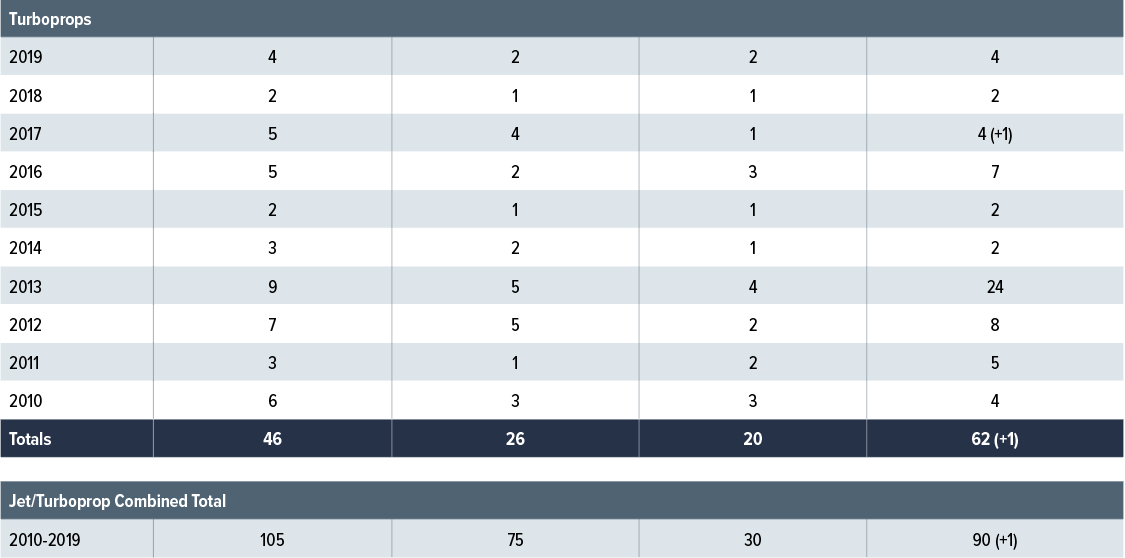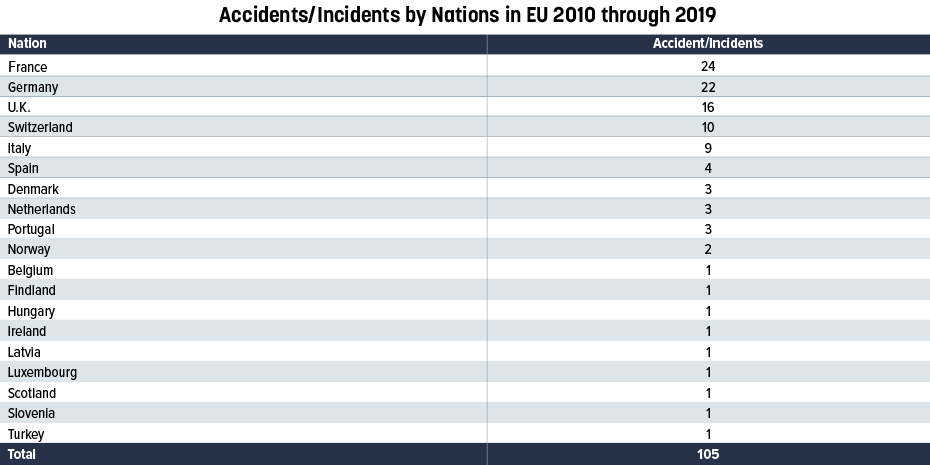Click Here to View This Page on Production Frontend
Click Here to Export Node Content
Click Here to View Printer-Friendly Version (Raw Backend)
Note: front-end display has links to styled print versions.
Content Node ID: 400746
An AIN study of turbine business airplane safety statistics from 2010 through 2019 in the then-28 countries of the European Union revealed 105 total accidents. Of these, 75 were nonfatal mishaps and 30 (more than a quarter of the total accidents) were fatal, taking the lives of 92 people. The majority of aircraft were of European and U.S. registration.
According to the research by AIN, of the 59 total business jet accidents or incidents over the last decade, 49 were nonfatal mishaps and 10 were fatal accidents, claiming the lives of 28 people. But business jets had no fatal accidents in Europe in 2019. In addition to last year, jets experienced no crashes whatsoever in 2016 and 2011. However, nonfatal accidents reached double digits in 2017 and in 2012.
Unlike their jet counterparts, turboprops suffered fatal and nonfatal accidents in every year of the last decade. Also, while the total number of turboprop accidents was 15 fewer than for jets, the number of fatal accidents and the number of fatalities were double that for jets. The year 2013 was the worst 12-month period for turboprops, with 24 deaths in four crashes. Note that 20 of those fatalities resulted from just two accidents, both involving skydiving missions. In 2017, a fatal turboprop crash killed one person on the ground, the only accident in the study that harmed someone who was not on the aircraft.
Accidents or incidents (defined as occurrences resulting in minor damage and/or minor injury) during corporate or private business flights accounted for 72 of the reported turbine airplane mishaps (more than 65 percent of the total). Charter passenger flights resulted in nine accidents/incidents, including two of the 10 fatal business jet crashes. The remaining events involved ferry or positioning flights, skydiving, flight testing, aerial survey, training, ambulance, civilian government, or unknown operations.
It can be seen from the accompanying chart that the vast majority of mishaps over the 10-year study period were classified as incidents rather than accidents. What’s more, in the case of jets, more than 60 percent of occurrences were incidents. It can also be concluded from this data that private operations accounted for the vast majority of mishaps—not altogether surprising since this is the most numerous type of flying in Europe, as it is elsewhere.
One fatal accident was the March 1, 2012 controlled flight into terrain (CFIT) involving a Cessna Citation 750 on a private business flight in Germany. The two pilots and three passengers were killed when the twinjet flew into terrain on the final approach. During the night approach, the crew switched from IFR to VFR. Shortly afterward, the jet struck trees, became inverted, and crashed and burned about two miles from the runway threshold. At the time of the accident, there was a cloud base some 500 feet agl and the dew point and temperature were both at eight degrees centigrade.
Citation Stunt Ends Badly
German airspace at night was also the venue for another fatal accident on Feb. 14, 2010, in which the crew on a ferry flight lost control of their Citation 550B after intentionally rolling the business jet. The two pilots were killed. According to the final investigation report, the tragedy was initiated when the copilot asked the captain if she had ever flown a roll at night.
At about FL260, the captain asked the copilot if their altitude was high enough to perform a roll. “The copilot confirmed that the altitude was sufficient.” Five seconds later the nose pitched up to 14 degrees and the crew initiated a roll to the right. Within four seconds the airplane was flying upside down. It rolled a further 90 degrees in the next four seconds. Meanwhile the nose dropped to a vertical dive of 85 degrees, the airspeed increased from about 240 knots at the initiation of the roll to 380 knots during the descent into the ground.
The single fatality involving a business jet in 2018 was a bizarre one that happened with a Gulfstream G150 on the ramp at an airport in Finland on January 5. After the captain started the APU to run cabin heat, he deplaned, closed the door and went to help the copilot remove snow from the aircraft.
A little later the cabin attendant inside the aircraft felt a “strange pressure in her ears and chest.” She went into the cockpit and got the attention of the pilots working outside by knocking on the window. According to the copilot’s observations, it was unusually difficult for the captain to get the door open. Then, as he pulled harder on the handle, the door suddenly “blew open with excessive force, hitting the captain who was standing underneath the door and knocking him to the ground.” He died from his injuries.
Business jets were in seven other fatal accidents over the last 10 years. On July 31, 2015, in the UK, the four occupants aboard an Embraer Phenom 300 were killed when the light jet landed long and fast, went off the end of the runway, and crashed into a parking lot. In France, on March 4, 2013, the crew of a Beech Premier 1 failed to remove ice and snow from the aircraft before it took off. It soon stalled and crashed, killing the two pilots.
On Jan. 12, 2014, four lives were lost when a Citation ISP crashed on the approach to an airport in Germany during thick fog. Three people died in the July 13, 2012 crash of a GIV after a runway excursion during landing at an airport in France. After multiple approach attempts at night, the three occupants of a chartered Citation Mustang died when the light jet crashed on final approach in turbulence and snow to an airport in Germany on Dec. 14, 2017.
Another CFIT approach accident was fatal to the two pilots of a Citation I on Aug. 2, 2012, during a positioning flight to an airport in Spain. It crashed one mile from the runway threshold. On Dec. 19, 2010, the two occupants of a Premier I died when the aircraft stalled while turning to the final approach course to an airport in Switzerland.
Four Fatal TBM Turboprop Accidents
Between 2011 and 2014, Socata TBM single-engine turboprops on private flights were in five crashes in Europe (all in France). Four of them were fatal to 11 people; and three involved loss of control. In the worst of the accidents, on Nov. 11, 2013, six people died when their TBM700 went out of control and crashed into terrain at night. Two people were killed on Aug. 6, 2014, when their TBM700, at altitude, went out of control and crashed. On Aug. 8, 2013, a TBM850 pilot making an approach lost control and crashed short of the runway killing all three occupants. Finally, on Nov. 11, 2011, a TBM700 crashed on final approach, killing the pilot.
The takeoff crash of a Piper Cheyenne in Portugal on April 17, 2017, was the only accident in the decade to cause a fatality other than crew or passengers. Shortly after takeoff, the turboprop twin lost power in the left engine, lost control, and crashed into a parking lot killing all four of the aircraft’s occupants and the driver of a truck.



*Accidents in this category included ambulance, ferry or positioning, skydiving, flight tests, aerial survey and training.